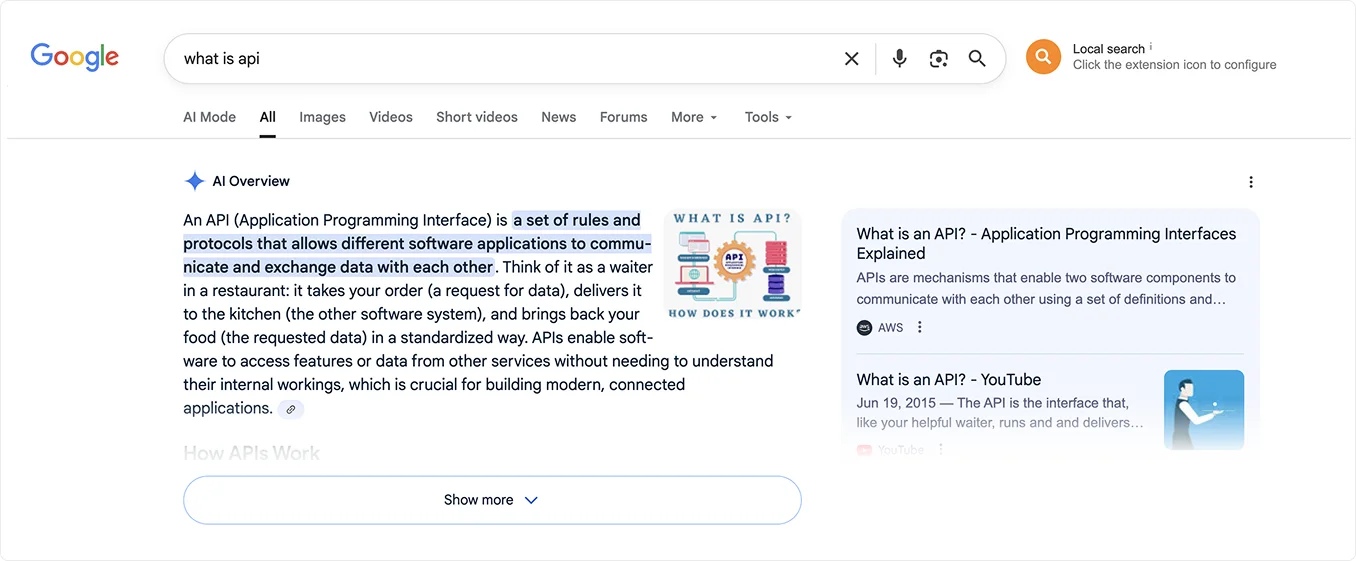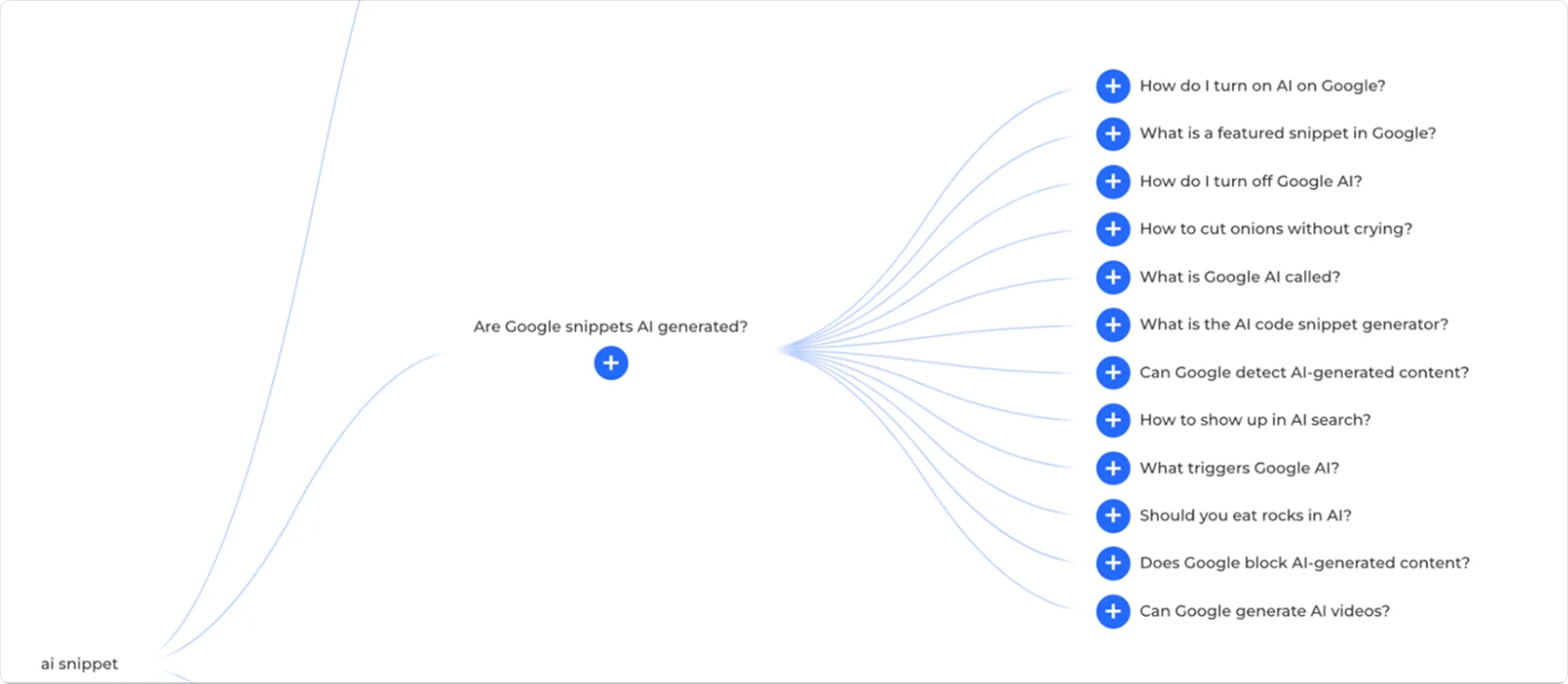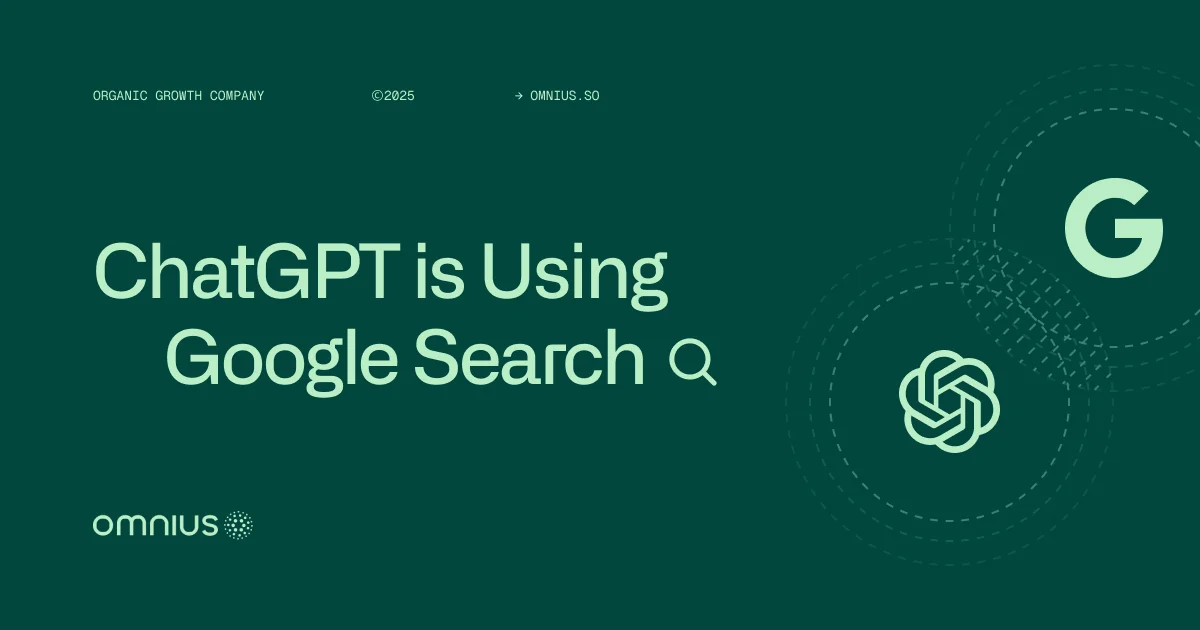The summer of 2025 confirmed what many of us in the SEO community suspected: AI isn't just a new technology; it's a new layer of the search engine, and your content's visibility in it depends entirely on your SEO.
During July, Aleyda Solis, Abhishek Iyer, and other SEO experts demonstrated that platforms like ChatGPT often draw directly from Google's top results, particularly when Bing falls short of providing accurate information.
They have once again proved that SEO is not just alive, it's fueling AI overviews and outputs.
Now we have proof that your content's appearance in AI platforms isn't random. It's a direct result of how well you've optimized your site for Google and other search engines, with a strong emphasis on earning featured snippets.
This article will walk you through their step-by-step findings, revealing exactly how LLMs are leveraging Google's content. We'll then show you how we at Omnius are putting these insights into practice, demonstrating how we optimize content to secure mentions and visibility in AI-generated answers for our clients.
Abhishek Iyer's 'Nonsense Word' Experiment
A few days before Alyeda's big test, we saw a test created by Abhishek Iyer on the X platform. He ran a simple but clever test to see if ChatGPT pulls information from Google’s index.
Here’s what he did:
- He created a completely new, nonsensical word (“myshkalapatnaik”) that didn’t exist anywhere online. I can’t even type it, as it is a very complicated, random word.
- He put this word and its definition on a hidden webpage, a page that had no links pointing to it.
- He used Google Search Console to manually get Google to index that page, but he didn’t let Bing, DuckDuckGo, or Yandex know it existed.
- He then asked ChatGPT Plus to define the word. ChatGPT’s answer matched his hidden page exactly, word for word.
- To double-check, he searched for the term in Bing, DuckDuckGo, and Yandex. None of them had any results.
What did we learn from his experiment?
- If your content is indexed and visible in Google, ChatGPT Plus can pull from it, even for very specific or niche queries.
- ChatGPT Plus can access information from pages that are not linked to or publicly discoverable..
What did Aleyda Solis's "snippet" test look like?
In her test, Aleyda created a new webpage on her website, but didn't submit it to any search engines. Initially, ChatGPT was unable to locate the page. It said the URL wasn't indexed.
But Gemini could find it. It fetched the content directly from the live page. This was a key difference.
Next, Aleyda submitted the page to Google Search Console and Bing. Google indexed the page in a few hours. It took a considerable amount of time (more than a few hours) for Bing to index it during this experiment.
She asked ChatGPT about the page again while it was indexed only on Google. This time, it gave an incomplete summary. It was a small piece of text. It matched the snippet from Google's search results.
The information was not sourced from Bing because it had not been indexed there yet. Later, Bing finally indexed the page. But ChatGPT still ignored it. It continued to use snippets from Google instead.
Aleyda's experiment showed us a few things:
- ChatGPT requires access to Google's index to find new pages.
- It can only utilize information from a page once it receives a Google snippet.
- Even if Bing indexes a page, ChatGPT still relies on Google's data for content.
- To get mentioned in ChatGPT, one of the crucial factors is optimisation for Google snippets (but it is not the only one)
From Theory to Practice: What This Means for Your Business
Even without a direct click, shaping AI responses enables your brand to establish authority with decision-makers before they ever visit your site. In many cases, the first interaction a prospect has with your company won’t be your homepage, but a Google snippet or an AI overview. That makes the snippet the true front door to your brand. And with the competitive edge narrowing, if a competitor controls that snippet, they control the narrative in AI-driven search.
Now, let’s move from theory to practice. In the next segment, I will show you simple examples, how we optimize content to appear in snippets.
1. Structure your Content for Clarity
AI models prefer organized and scannable content, ideally positioned at the top of your page. They are designed to scan, understand, and extract clear answers, so it's important to make this process as straightforward as possible. Begin with the solution and present it directly at the top of your page. The clearer and more scannable your answer is, the more likely it is that AI will recognize you as an authoritative source.
In the SaaS and fintech space, my goal as an editor is to understand complex, jargon-heavy concepts and explain them in plain English. For instance, if I were editing an article about APIs, I would ask the writer to clarify that an API acts as a bridge that enables two different applications to communicate. This way, even those unfamiliar with the niche can better grasp the articles discussing these intricate topics. Additionally, AI prefers this type of content and considers it a definitive source.

2. Focus on question-based headings, and avoid generic ones
While using a language model (LLM) to generate content can be tempting, unedited outputs often result in generic headlines. However, if you don't edit what the LLM produces, you may end up with generic headlines that attract little to no traffic.
Focus on using semantically similar keywords in your headlines. Explore Google's "People also ask" section, utilize tools like AlsoAsked, or develop your own methods to analyze how your audience is asking questions online.

This approach will help you create headlines that reflect how people actually phrase their questions in search. For example, instead of using the title "Conclusion," consider something more engaging, such as "How to show up in AI search?”.
3. Start your paragraph with a direct answer
The first paragraph immediately following a question-based heading should deliver a clear, 1–2 sentence answer. Think of it as a mini-featured snippet: short, direct, and written to stand on its own. After that, you can expand with context, examples, and supporting details.
The challenge is that many content writers do the opposite. They open with long, winding intros. Yes, they are setting the stage, adding background, or trying to “hook” the reader before ever addressing the actual question. However, while this approach may seem natural from a storytelling perspective, it creates friction for both users and search engines.

Readers looking for a quick answer will skim past it or bounce, and AI models that rely on snippets will miss the key takeaway entirely.
By front-loading the answer, you respect the reader's time and position your content to be the version Google and AI models choose to quote.
You can see that I wrote the most important information first, followed by an explanation.
4. AI models love lists and tables:
For complex topics, use bullet points, numbered lists, and data tables. AI models are highly likely to pull these structured elements directly into their overviews.
In SaaS and fintech content, tables and lists are gold when the reader needs to compare, scan, or act quickly. They help decision-makers (your target audience) absorb complex information without wading through walls of text. Here’s when they work best:
Use Tables when you need to:
1. Compare pricing or features
- Example: Side-by-side comparison of product tiers (Basic, Pro, Enterprise).
- Why: Buyers want to see differences at a glance, not buried in paragraphs.
2. Show ROI or cost breakdowns
- Example: “Cost of manual compliance vs. automated compliance with our software.”
- Why: Tables make financial impact obvious for CFOs and procurement teams.
3. Highlight metrics or performance benchmarks
- Example: Uptime %, transaction speeds, error rates.
- Why: In fintech especially, numbers carry weight — a table makes them credible and scannable.
4. Summarize regulatory requirements
- Example: Different compliance standards (PCI DSS, PSD2, GDPR) and how your platform addresses each.
- Why: Perfect for showing coverage and building trust with risk-averse audiences.
Use Lists when you need to:
1. Explain steps or workflows
- Example: “How to onboard a new vendor in our platform” (Step 1, Step 2…).
- Why: Lists make processes feel actionable and frictionless.
2. Highlight benefits or features
- Example: “5 security safeguards included in our solution.”
- Why: Quick way for decision-makers to see value props.
3. Prioritize actions or best practices
- Example: “Top 3 ways to reduce fraud risk with automation.”
- Why: Lists turn strategy into a punchy, memorable framework.
4. Break down risks or challenges
- Example: “Common pitfalls in vendor onboarding and how to avoid them.”
- Why: Shows you understand the buyer’s pain points while offering a solution.
5. Prioritize E-E-A-T Signals
Experience, Expertise, Authoritativeness, and Trustworthiness (E-E-A-T) are critical for both human readers and AI models. AI models are trained to prioritize information from credible sources. Here is how it looks in the SaaS and Fintech environment.
Experience
Show that you or your company has first-hand knowledge of the problem.
- Example: “Our compliance team processed more than 3,000 vendor risk assessments last year. Here’s what we learned about reducing approval time.”
- Why it works: Readers see that you have lived the workflow, not just described it.
Expertise
Highlight the skills, qualifications, or deep industry knowledge of the author or brand.
- Example: Blog posts authored by a Head of Risk & Compliance (CAMS certified) explaining PSD2 implications for fintech firms.
- Why it works: Professional credentials and specialized knowledge lend credibility to the advice.
Authoritativeness
Show that others recognize and rely on your work.
- Example: "Our fraud detection benchmarks are cited by Fintech Magazine and trusted by five of the top ten European banks.”
- Why it works: Endorsements from outside sources prove leadership in the field.
Trustworthiness
Give readers confidence that your content and platform are reliable.
- Example: Adding audit certifications (SOC 2, ISO 27001) on product pages, publishing transparent uptime dashboards, or sharing verified customer testimonials.
- Why it works: Clear evidence of compliance and security reduces perceived risk in SaaS and fintech.
6. Use Author Bylines
Ensure that content does not exist in isolation. Include an author byline that highlights the author's credentials. If the content is for a company blog, specify the author's title and provide a link to their professional profile, such as LinkedIn. It's even more effective when two experts collaborate on the content: one writes while the other serves as the editor.

7. Cite Your Sources
When you make a claim or present a statistic, always link to the original research or a reputable publication. This serves as a powerful trust signal for both Google and AI models. I often read articles that contain statistics but lack proper sources. To me, this is a clear indication that the author may have used a language model for content generation but neglected to edit or fact-check it. That kind of writing is fundamentally counterproductive, and it is something that we are really careful about here at Omnius. Check out how we do that in our GEO industry report.

8. Feature Real People
Showcase case studies, testimonials, expert roundups, and customer stories. AI models are increasingly valuing content that demonstrates real-world experience and results.
My personal favorite for getting quotes from experts is a website named Quoted, but if you have an active LinkedIn network, you can also use it to get expert opinion, which you will use in your content.

9. Implement Technical SEO
The technical part is crucial for AI-powered search, as it ensures that the algorithms have all the necessary information to interpret your pages correctly.
Here are some key technical SEO elements to focus on:
- Indexability: If your page isn't in Google's index, it can't be found by anyone. Use Google Search Console to submit your sitemap and monitor for any indexing errors that might prevent your key pages from being discovered.
- Structured Data (Schema Markup): This is a powerful way to give search engines a clear, structured roadmap of your content. Implementing specific schema types, such as FAQPage or HowTo schema, tells Google and other AI-powered crawlers exactly what information to pull from your page, often leading to rich snippets and better visibility in search results.
- Meta Descriptions: While not a direct ranking factor, well-written meta descriptions often serve as the basis for the snippets that Google displays. Make them concise, descriptive, and compelling to encourage clicks,
- Image Optimization: Optimize your images to improve page load speed and provide context to search engines. Use descriptive file names, compress images to reduce file size without sacrificing quality, and, most importantly, fill out the meta alt tags. This tag not only helps search engine crawlers understand what the image is about, but also provides accessibility for visually impaired users.
Building Authority in the New Search Environment
Zero-click searches are the norm today, and your brand's first impression is no longer a homepage.
It is a Google snippet or a search overview.
This shift creates a powerful new opportunity. Securing a mention in a generated answer establishes your business as a trusted authority, building brand visibility and credibility with every query.
This is your chance to own the conversation. If you are ready to position your brand as the definitive source in your industry but lack the time or expertise, our team at Omnius is ready to help. Schedule a free content audit with us today, and let's develop a strategy to establish your brand as a recognized authority in search.
Keep Learning
Google’s SGE Review - 7 Shocking Insights You Should Know [Explained]
What is Google AI Mode & How It Will Impact Your Business in 2025
How to Rank in Google AI Overviews with 8 Actionable Steps?
The ChatGPT 52% Referral Crash: Why Betting on One Organic Channel Can Be a Risk









.png)

.svg)








.svg)













.png)

.png)


